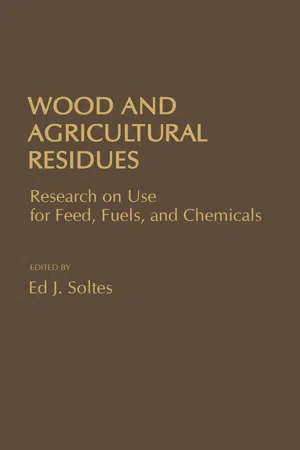
- 632 pages
- English
- PDF
- Available on iOS & Android
About this book
Wood and Agricultural Residues Research on Use for Feed, Fuels, and Chemicals covers the proceedings of the 1982 "Feed, Fuels, and Chemicals from Wood and Agricultural Residues symposium, held in Kansas City and sponsored by Cellulose, Paper, and Textile Division of the American Chemical Society. Organized into seven parts encompassing 31 chapters, the book discusses the plant cell wall; the cellulose, hemicelluloses, and lignin; the lignocellulosics for ruminants; the biological and thermochemical conversion; and the approached for utilization. The introductory part describes the anatomy, permeability, ultrastructure, and digestion of plant cell wall. The following section examines the structure, characteristics, derivatives, recycle and recovery through solvent systems, and utilization for enzyme and protein production of cellulose and hemicelluloses. This section also discusses the synthesis, structure, properties, and analysis of hydroxypropyl lignin derivatives. The third section characterizes the fibrous fractions of forages and presents traditional methods for qualitative and quantitative analyses of lignocellulosics. This text includes discussions on methods for improving utilization of unconventional feed sources by ruminants; the digestion impeding factors; and the effect of chemical, physical, and biological treatments in upgrading the digestibility and nutritive value of crop residues. The subsequent sections describe the biological, chemical, physical, and thermochemical conversion of wood fibers. Such methods include fermentation, acid and steam hydrolysis, saccharification, hydrogenolysis, and pyrolysis. The concluding section covers mechanical treatments to improve lignocelluloses properties, such as steam explosion and solvent systems. This book is an ideal source of information for botanists and feed scientists and researchers.
Frequently asked questions
- Essential is ideal for learners and professionals who enjoy exploring a wide range of subjects. Access the Essential Library with 800,000+ trusted titles and best-sellers across business, personal growth, and the humanities. Includes unlimited reading time and Standard Read Aloud voice.
- Complete: Perfect for advanced learners and researchers needing full, unrestricted access. Unlock 1.4M+ books across hundreds of subjects, including academic and specialized titles. The Complete Plan also includes advanced features like Premium Read Aloud and Research Assistant.
Please note we cannot support devices running on iOS 13 and Android 7 or earlier. Learn more about using the app.
Information
Table of contents
- Front Cover
- Wood and Agricultural Residues: Research on Use for Feed, Fuels, and Chemicals
- Copyright Page
- Table of Contents
- Contributors
- Preface
- Part I: The Plant Cell Wall
- Part II: Cellulose, Hemicellulose, and Lignin
- Part III: Lignocellulosics for Ruminants
- Part IV: Biological Conversion
- Part V: Chemical/Physical Conversion
- Part VI: Thermochemical Conversion
- Part VII: Utilization Overviews
- Index